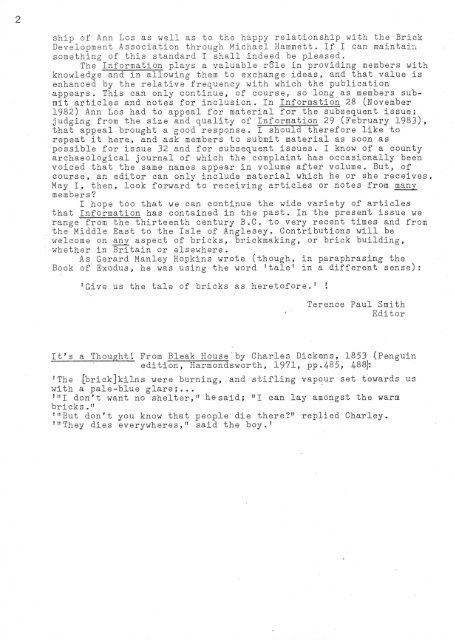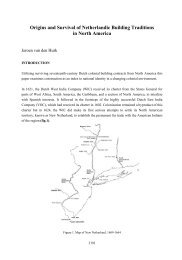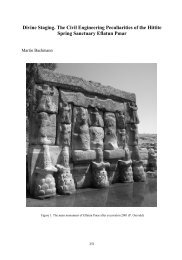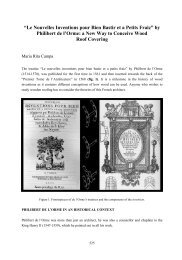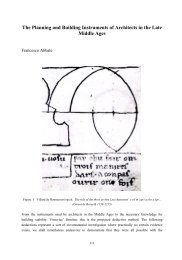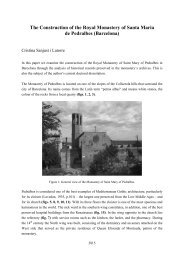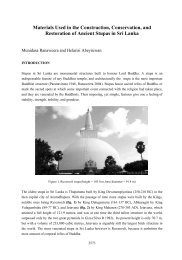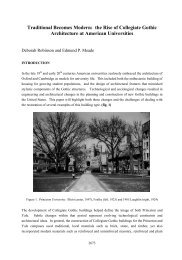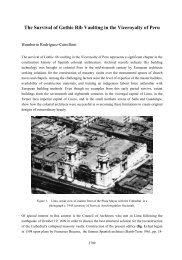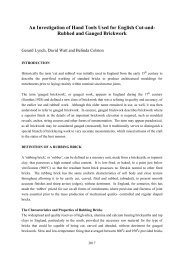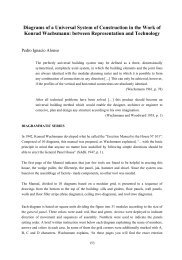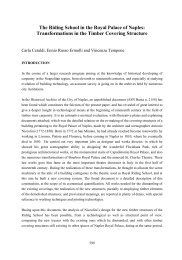bricks from the - Department of Architecture
bricks from the - Department of Architecture
bricks from the - Department of Architecture
Create successful ePaper yourself
Turn your PDF publications into a flip-book with our unique Google optimized e-Paper software.
2<br />
ship <strong>of</strong> Ann Los as well as to <strong>the</strong> happy relationship with <strong>the</strong> Brick<br />
Development Association through Michael Harnrnett.If I can maintai:l<br />
something <strong>of</strong> this standard I shall indeed be pleased.<br />
The Information plays a valuable r8le in providing members with<br />
knowledge and in allowing <strong>the</strong>m to exchange ideas, and that value is<br />
enhanced by <strong>the</strong> relative frequency with which <strong>the</strong> publication<br />
appears. This can only continue, <strong>of</strong> course, so long as members submit<br />
articles and notes for inclusion. In Information 28 (November<br />
1982) Ann Los had to appeal for material for <strong>the</strong> subsequent issue;<br />
judging <strong>from</strong> <strong>the</strong> size and quality <strong>of</strong> Information 29 (February 1983),<br />
that appeal brought a good response. I should <strong>the</strong>refore like to<br />
repeat it here, and ask members to submit material as soon as<br />
possible for issue 32 and for subsequent issues. I know <strong>of</strong> a county<br />
archaeological journal <strong>of</strong> which <strong>the</strong> complaint has occasionally been<br />
voiced that <strong>the</strong> same names appear in volume after volume. But, <strong>of</strong><br />
course, an editor can only include material which he or shereceives.<br />
May I, <strong>the</strong>n, look forward to receiving articles or notes <strong>from</strong> many<br />
members?<br />
I hope too that we can continue "<strong>the</strong> wide variety <strong>of</strong> articles<br />
that Information has contained in <strong>the</strong> past. In <strong>the</strong> present issue we<br />
range <strong>from</strong> <strong>the</strong> thirteenth century B.C. to very recent times and <strong>from</strong><br />
<strong>the</strong> Middle East to <strong>the</strong> Isle <strong>of</strong> Anglesey. Contributions will be<br />
welcome on any aspect <strong>of</strong> <strong>bricks</strong>, brickmaking, or brick building,<br />
whe<strong>the</strong>r in Britain or elsewhere.<br />
As Gerard Manley Hopkins wrote (though, in paraphrasing <strong>the</strong><br />
Book <strong>of</strong> Exodus, he was using <strong>the</strong> word 'tale' in a different sense):<br />
IGive us <strong>the</strong> tale <strong>of</strong> <strong>bricks</strong> as heret<strong>of</strong>ore.'<br />
Terence Paul Smith<br />
Editor<br />
It's a Thought~ From Bleak House"by Charles Dickens, 1853 (Penguin<br />
edi tion, Harmondsworth, 1971, pp. 485, 488):<br />
'The~rickJkilns were burning, and stifling vapeur set t~wards us<br />
with a pale-blue glare;... "<br />
111 I don' t want no shel ter, 11 he said; 11 I can lay amengst <strong>the</strong> warm<br />
<strong>bricks</strong>."<br />
IIIBut don't you know that people die <strong>the</strong>re?" replied Charley.<br />
111 They dies everywheres, 11 said <strong>the</strong> boy. I


